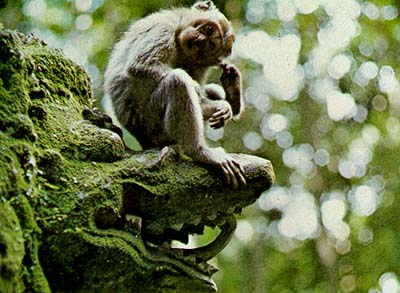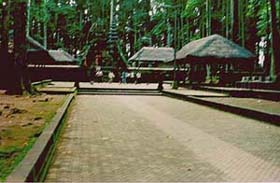
Sangeh
|
|
Rawana,
the villainous
giant of the Ramayana epic, could die neither on earth nor in air. To
kill him, themonkey general Hanuman devised a plan to suffocate the
giant by pressing him between two halves of the holy mountain
Mahameru-a destruction between the earth and air. When Hanuman took
Mahameru, part of the mountain fell to the earth in Sangeh, along with
a group of his monkey armies. And so they stayed to this very day.
|

|
|
Such is
the legendary
origin of Bukit Sari, or The Monkey Forest, a cluster of towering trees
and home of hundreds of sprite monkeys. The forest is sacred and for
many years no one has been permitted to chop wood there. A moss-covered
temple lies in the heart of the woods and is a familiar hideout for the
nimble inhabitants. You make many friends by buying a bag of peanuts,
and for such a feast the monkeys often bring their families along.
|
|
Rumor
tells of a king of
the monkeys who invariably has the first choice in selecting peanut
handouts. He oversees one camp, while a rival king and his followers
control another area of the forest. A beautiful restive place, Sangeh
has long been an inspiration for painters and monkey-watchers.
|
|
The
temple, Pura Bukit
Sari, was originally built around the 17th century as an agricultural
temple and has been restored several times, most recently in 1973. In
the central courtyard, a large statue of Garuda, an old carving of
uncertain date, symbolizes freedom from suffering and the attainment of
amerta, the elixir of life. The forest of nutmeg trees in which it lies
was presumably planted deliberately a long time ago, for it is unique
in Bali.
|

|
There is a
separate
route linking Sangeh directly with Denpasar that begins at Jalan
Kartini, making it a short trip. A side - road joins Blahkiuh, just
south of Sangeh, with Mengwi which can also be reached by returning to
Denpasar and taking the trip to the west. A sub-standard road links
Sangeh with Ubud.
|
Copyright
© 2001-2011, K&D Bali Designs. All rights reserved.
|